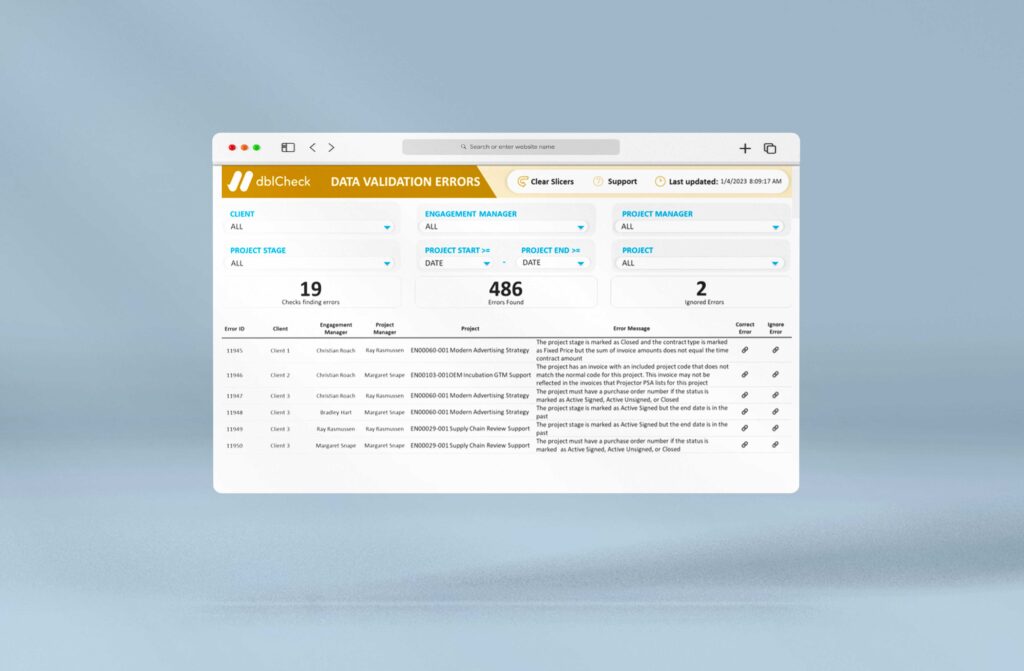Sometimes you have to say out loud what everyone already knows.
We are going to make the case for improving the quality of data to deliver greater insights and as a way to build executive confidence in reports and findings. Then, having persuaded you that good data is better than bad data (a case we are hoping to win), we will offer one way for you to dramatically improve your data – especially if you are a user of Projector PSA by BigTime Software.
We work with several technology, energy and financial services companies building dashboards that are intended for executive communications and streamlined operations. We are hired, in no small part, because we can take information from disparate systems, manage consistent and accurate transformation processes, and load the normalized data into engaging executive-ready dashboards.
Often, we hit a problem when we encounter basic data inaccuracies. For example, at a large technology company they had customer records that refer to the same customer using different names, abbreviations, and spellings. This is fairly easy to fix. The transformation data rules are easily extended until we have one customer name per customer. Whew! Problem solved.
Sometimes we encounter harder problems. For example, at a technical engineering company, some data was simply blank – with information filled in intermittently. The client needed granular reporting so we could not simply build dashboards based on statistical trends. And they had cases where different information was required at different stages of their engineering engagements. The result was a complex and situation-dependent set of rules determining what was required.
Thus, was born dblCheck. dblCheck is a software plug-in that allows us to take extracts of data from Projector PSA by BigTime Software and build dynamic checks that identify data errors, offer simple English explanations of what must be corrected and directs the user to where they need to go fix the problem.
The results for the technical engineering company were dramatic. They fixed most of their Projector PSA data in just a couple of weeks. Not only could they develop business insights more quickly and more accurately, but they also saved many hours every month because client, engagement, invoice, and project data validated overnight – and when one or more errors was detected – they were fixed in minutes. Boom.
This improvement in data quality cascaded to the financial systems where significant time is saved each month as there are vastly fewer errors and therefore vastly fewer things to research and correct. For the operations team, the improvement is especially noticeable. Instead of creating PowerPoint summaries of data (with manual corrections) they show live dashboards to the executive team and drill down wherever they need more information.
Something we did not expect: The engineering company is excited to add validation checks and adjust others, so their business data evolves at the same pace as their business. No configuration. No IT. No work arounds.
dblCheck was so effective for the engineering firm, we applied it to our own data infrastructure. Below is screen shot using rGen’s own data drawn from Projector PSA. We execute approximately 50 complex data validation checks that examine all aspects of our business data. Because our extracts of data identify the location of the error in the system, users can click on an error, and they are taken directly to the Projector PSA screen on which a correction can be made. Click. Fix. Done.

Two things about dblCheck took time. The biggest of these was creating a Boolean interpreter that allows us to build custom rules using any CSV or Web Services extract. The second was building the business rules that are unique to our business and therefore not in Projector (or any other PSA as far as we can tell). For example, milestone amounts for fixed-priced contracts must be entered at the point in time a project is bid. Then, the milestone total must be exactly the same as the forecast contract amount. (a little inside baseball, but you get the idea – complex and even nuanced rules are possible)
If you are a Projector user (or have other systems with limited data validation capabilities), would your organization benefit from more accurate and complete data? Almost certainly. With accurate, validated data, dashboards can be executive-ready at any time. Operations runs more smoothly. And finance work effort is diminished dramatically.
Can you build your own dblCheck? For many organizations, again, almost certainly. But consider the benefit of focusing only on the business rules and getting your data into great shape in record time. No IT development. No laborious brute force effort by finance and operations. And imagine adjusting those validation checks in just minutes as your business evolves. Your dashboards and your executive team will thank you to say nothing of finally getting the finance specialist to actually smile.
Contact us at info@rgenconsulting.com if you would like more information on how you can get your data into great shape in record time.

